Making Pastéis de Nata
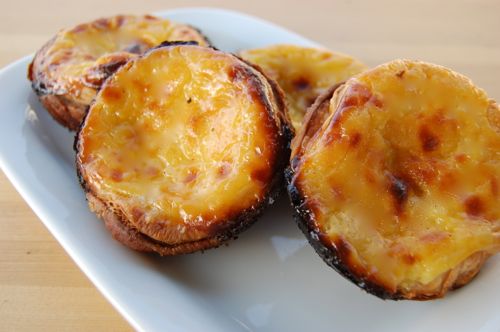
These things are really neat. They’re little, rich, aromatic and caramelly. As perfect an afternoon sweet as I’ve ever made. Not that I’d call these particular pastéis perfect. They’re a little too toasty. Yet they passed muster with a one of Mrs. Pastry’s Portuguese colleagues, who claimed they tasted just like home. She was probably being nice. Yet there’s no denying even these first-attempt pastéis had a certain…something. I’ll definitely be making them again. They’re one of the few pastries I’ve made that both my little girls loved.
The big myth about pastéis de Belém (also know by the more generic term, pastéis de nata, or “cream tarts”) is that they must be baked at a very high temperature, up to 750 degrees Fahrenheit. That’s erroneous in my view. I found that even 550 degrees Fahrenheit was too much. Next time I’ll bake at 475 (about the max for puff pastry) and finish them under a low broiler if they haven’t developed their characteristic brown spots after 25 minutes.
Here I should stick in a word about forms. Jumbo muffin pans are the perfect size form for pastéis de Belém. Smaller (or larger) forms will work, but whatever you choose make sure your pan doesn’t have a nonstick coating, as nonstick coatings break down over about 450 degrees into toxic compounds. Plain steel or aluminum is what you want.
So preheat your oven to 475 degrees Fahrenheit and assemble your ingredients. Roll out about 1 1/2 pounds of puff pastry to make your crusts. Homemade pastry is what really makes these little pies shine. Use it if at all possible. Here’s I have a roughly 1 1/2 pound piece:
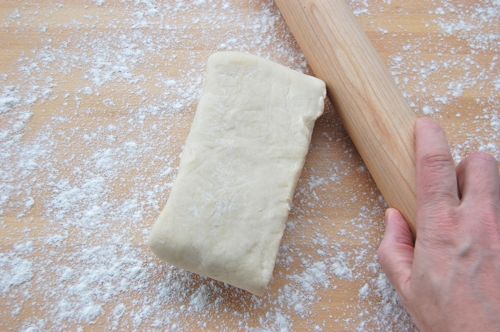
I roll it out very thin, to about 1/8″…
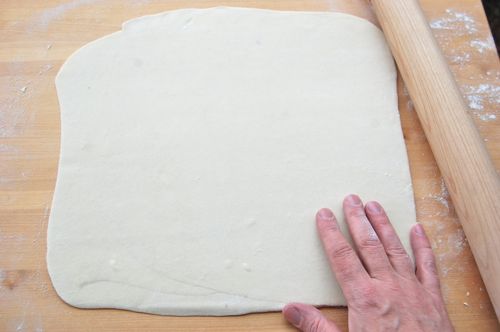
…then use a round cutter to make my rounds. Cut out as many as you can on your sheet. You can reuse the scraps, just make sure you don’t ball them up first. Stack the pieces on top of each other, then apply the pin. That way you’ll preserve your horizontal layers.
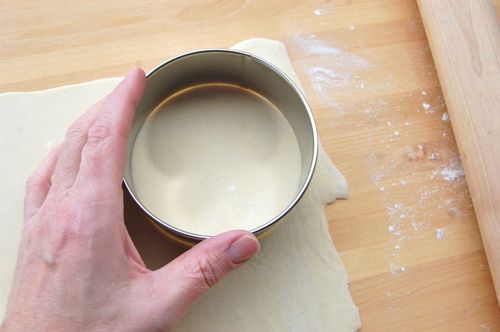
Lay them into the buttered forms. You want the dough to come about half way up the muffin mold. Notice my failed attempt at the classic shaping technique on the right. In Portugal you shape these by rolling your pastry into a slender log, cutting the log in sections and standing a section up in each form. You then wet your finger, stick it into the middle of the roll, and pull the dough outward until it lines the mold. That doesn’t work in North America, because the gluten in our flour is much too stretchy and elastic. Oh well…the end result will be almost identical to the original. When all your forms are lined with pastry, put them into the refrigerator to rest while you work on the filling.
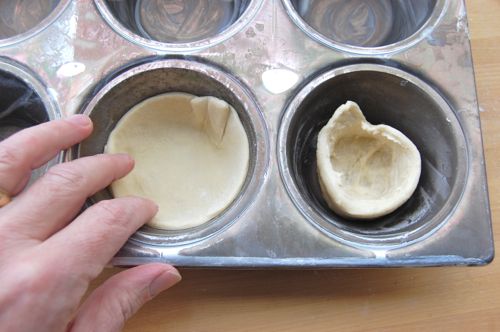
Begin the filling by combining the flour with about 1/2 cup of the milk. Whisk it into a paste.

Next, combine the milk, vanilla, lemon peel and cinnamon stick in a small saucepan. Bring it to the boil.
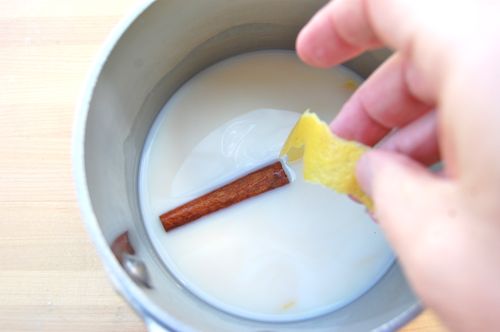
When it’s boiling, add the milk/flour mixture. Quickly whisk it in and remove the pan from the heat. Allow that to cool while you make your syrup.

Combine your sugar and water in a small saucepan. Bring it to the boil and cook it to 220 degrees Fahrenheit. Remove it from the heat and allow it to cool completely before you move on.
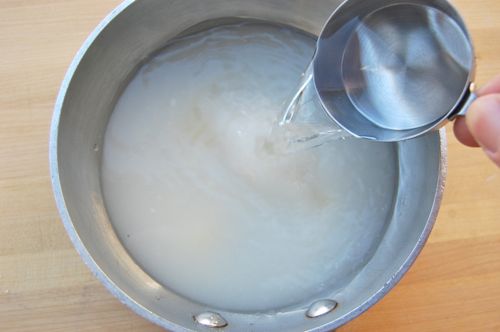
When they syrup is cool, whisk it into the milk mixture.

Pour everything through a strainer to remove the solids.
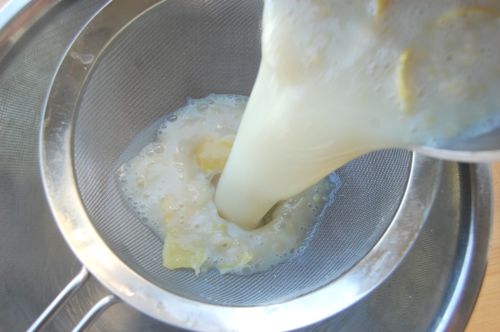
Now all you do is whisk in your egg yolks and you’re ready to rock n’ roll.
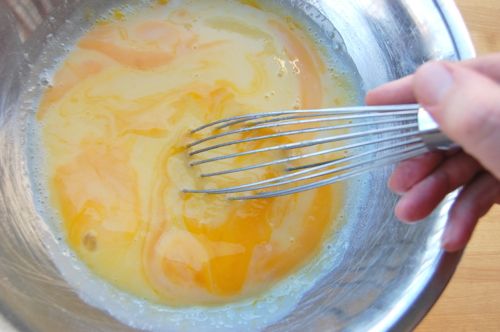
Take the pastry-lined forms out of the refrigerator and ladle in about 1/3 cup in each form. You want the filling to come only about three-quarters of the way up the sides of the pastry.

Bake them for about 20 minutes. Check after that time. The filling should be puff and the edges of the pastry golden. These were baked at 550 and you can see they puffed up a little too aggressively (resulting in cracks on the surface. 475 would have worked better I think. As the pasties cool they lose their puff and even fall in a little (that’s the aesthetic).
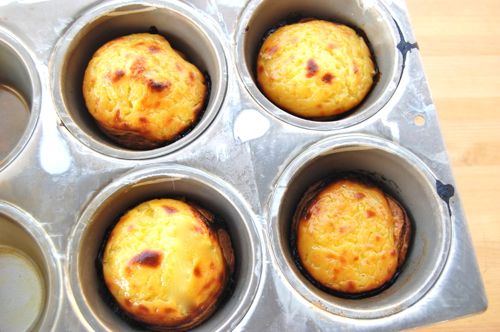
A proper pastel has those little brown spots on top. If the pastéis don’t have them but are fully baked, a low broiler should do the trick. I meant to test this but I was out of homemade pastry after this trial-and-error session was over. What? I’m only one man — I can only do so much! But you can see by this photo was pastéis de Belem are like: a sweet/cinnamon-y/eggy filling on top and rich and flaky below.
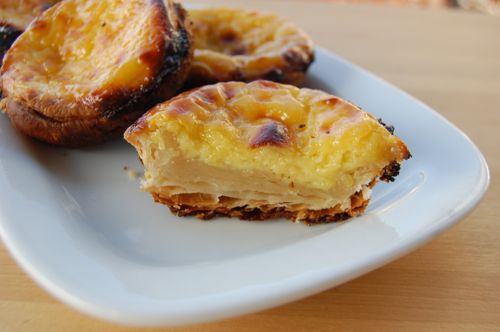
The combination is devastatingly good…warm or cold (which I actually prefer). Go to it!
I live in a Portuguese neighbourhood in TO (a very culinarily diverse city) and I eat these all the time. They’re so delicious. Sweet, but nourishing. Yours look lovely, though the pastry is puffier (and I’m sure more delicious) than that within the kinds I’ve tried. The ones here also tend to have more custard (probably cuz the pastry is flatter). I’d try to make them but it seems a bit crazy when there are 8 stores that make them 2 blocks away…
Hey K! You were right, this post was deleted by accident. As for trying pastes — why not? You never know what you might discover in the process! 😉
– Joe
But … you didn’t do the vertical lamination! I thought that was what made them pasteis de nata rather than ordinary custard tarts. Also, from my reading, the little brown spots are a side product of the high heat cooking rather than the aim – high heat being necessary to cook the pastry fast enough that the custard doesn’t break.
Honestly I can’t see how the sort of “flash setting” of custard that you’re describing could possibly work. I wish you could have seen how these tarts behaved in a 750-degree oven. As the laws of thermodynamics predict, the very outer regions (the bottom skin of the crust and the outer edges of the custard) burn and/or boil almost instantly, leaving the inside raw. After three minutes the edges of the crust begin to give off smoke, but the center of the tart is still completely liquid. Try it if you can and see. I swear I’m not making it up! 😉
– Joe
This is the stuff you find in those Chinese bakeries! Love em!
Just for calories sake, we always have sweet pastries with a generous serving of condensed milk. It always compensates the custard filling. These looks super stunning.
Ha! Sounds great. Actually, the condensed milk would serve the same purpose as the syrup: adding sweetness and creating that cooked caramel effect on the top.
– Joe
Looking great Joe, I am going to have to try out your recipe 🙂
This will kill my caramel craving!
It sure will! If you’re are caramel freak you’ve definitely found a new favorite snack. 😉
Cheers,
– Joe
My mom was a caterer who specialized in “exotic” foods back in the 50s & 60s. I grew up as the “third chef” (peeling 50 lb of potatoes or onions, shlepping stuff around) in a kitchen that cooked Greek one week and Indonesian the next. One thing I learned was that there is no one way any nation cooks any dish. Your mom would cook the thing the way she learned with the stuff she could get, some another mom in some other town used similar ways & similar stuff but it was not the same.
I struggled for years trying to get to the “authentic” and there is nothing wrong with the pursuit because it leads to many great meals. But it can also led you to put down some great food as “not quite right”.
I have been lurking here a long time & you get it right more often than you give yourself credit for. These read about as good as it gets. Enjoy the hell out of them & don’t put yourself down. They are probably as good as many you’d get there.
Thanks Frank, I appreciate that! I’m not a big believer in “authenticity” either. As you say, it’s a constantly moving target. That’s why I avoid using the word to the best of my ability. But you’re absolutely right: the fun is in the pursuit! Thanks again and have a great weekend!
– Joe
These goodies are hugely popular in Macau, and to some extent in Hong Kong too. I always wondered how they kept the custard filling smooth despite the need for baking at a high temperature for the puff pastry and the browned top – it seems that flour is the key! But then they probably don’t use so much that it interferes with the silky texture of a good still set custard. I wonder why this doesn’t require baking blind (as one has to with other non-puff pastry tarts)? I guess the puff pastry would have risen too much had one baked blind? Also, why the need for sugar syrup? Can’t one just add water and sugar to the milk and cream mixture? Thanks!
Hi Henry!
I think you’re right that the blind baking would cause an overly-high rise in the puff pastry. Also the filling needs to get hot enough that the top caramelizes. On which note, I think the syrup might serve a dual purpose: to further inhibit curdling and perhaps to promote faster caramelization of the top. Though I didn’t have the pastry (or the patience) to do a side-by-side test, I wondered if an evenly-distributed, pre-reduced syrup might caramelize more readily and uniformly than sugar crystals floating in the mixture. I don’t know, it’s just a theory. I should actually test that. Great question!
– Joe
Joe….
I’m here via Smitten Kitchen and I’m happy to say that I did not get mis-directed. Right now I’m into the chemistry of baking so your blog is right up my alley.
Anyway, working my way through your blog, I happened upon your post about Pastéis de Belém. The picture took me straight back to my trip to Portugal. I can just taste those little custard tarts that can be found 24/7. The Portuguese equivalent of the omnipresent American ‘donut’. Oh Yummm!
The tops look perfect. I seem to remember just a little more custard in the center. The bottoms do look a little on the toasty side. But if I were a recipient of these, I wouldn’t complain.
In closing, a most excellent blog. Love your ‘voice’, topics, pics and seemingly infinite patience.
I look forward to reading all the rest of your posts and hopefully baking along the way.
Regards!
Pepper
ps. I think you are correct about syrup inhibiting the curdling process. I seem to remember reading that somewhere else but it was in reference to using Karo.
Welcome, Pepper!
Thanks for all the kind words! But I’ll warn you as I warn others that too much Joe has been shown to cause brain damage in laboratory animals. So be careful.
– Joe
I really would like to make these, but I can’t seem to find the actual recipe anywhere. Am I missing it? Your site is awesome. Just stumbled upon it from smitten kitchen!
Hey Tracy!
Just head to the left side menu under Pastry. Click on the link and you’ll find the recipe in a separate post at the bottom. This is just my way of organizing.
Let me know if you’re still having trouble!
– Joe
I LOVE these tarts. Was introduced to them by a handsome fellow in a foreign city on a romantic couples trip. It turned into a torrid love affair… with the tarts, that is.
So I made these last night. The custard came out curdled (symbolic for the above relationship), but I followed all directions very closely so I’m not sure where I went wrong. I did add the syrup perhaps before it was fully cooled, and subbed in a small amount of lemon juice for the peel – would either of those create the curdling?
Tks in advance!
Ah yes, Meg, both of those things could have caused the curdling — the heat and especially the acid! That’s where the problem is. Give a try again! Lord knows I did…;)
– Joe
I, also, cannot find the recipe for pasteis de belem. Could you provide a complete link? Many thanks.
Sure, Doris. Give me a second.
– Joe
All set now, Doris. Thanks!
http://joepastry.com/2012/making-pasteis-de-belem/
Thank you, Joe, for your quick reply! Tomorrow is the day!
Let me know how they turn out!
– Joe
I cheated & used Trader Joe’s pastry With Butter. My friends who just returned from Spain and Portugal loved them. Their mouths dropped when they opened the box. Your website is awesome. Thank YOU! Doris
My very great pleasure, Doris, and thanks! I’ve served them to some Portuguese folks here (co-workers of Mrs. Pastry over at the University of Louisville) and they’ve flipped. I think the recipe is a winner! 😉
– Joe
… I like the article, however I must correct a few things:
– Pasteis de Belem is actually a trademark of the “Pasteis” made by the “Antiga Confeitaria de Belem”. You may say that they are a variation of the Pasteis de Nata because they look a LOT alike. However, the recipe is a secret (actually 2 secrets), but I can assure you it’s NOT the same as the Pasteis de Nata.
– Regarding the oven temperature: you may say the Pasteis de Belem break the laws of thermodynamics… 🙂
… oh and in the Pasteis de Belem… nooooo lemon, no butter, no vanilla and no cinnamon… that much I can say…
This is a great recipe for the Pasteis de Nata!
Congrats anyhow, because they look delicious.
Any formula you can provide would be welcome!
Cheers,
– J
Hey HPB! That’s very true. They are indeed proprietary. Pasteis de Nata is what most people call them when they don’t want to risk trademark infringement. I tried to split the different, though admittedly my solution wasn’t perfect.
Thanks for checking in!
– J
I can back this up as I have both been to this bakery (it’s around the corner from a famous monastery and is an absolute madhouse jammed to the rafters with shouty tart nuts) and live at Ground Zero of Toronto’s “Little Portugal”.
The Belem version has cinnamon (or cinnamon plus something secret) sprinkled on top after baking. It’s noticeably lighter in both pastry and custard than the “nata” versions, although I don’t mind a chewier tart like the kind I can get within walking distance. The lemon in most of them is merely suggestive; I can only recall one where I could really notice it. There’s a lot of variation in the baking, it seems. When a big tray is brought from kitchen to display case, you can see where the hot spots are in the industrial oven, and some customers will pre-order their preferred level of “brown spots”. Sometimes you’ll even see ones that resemble scorched open-faced cheese toast…they still taste good.
Two of these and three “expressos” is a very common sight at breakfast around here: Portuguese jet fuel!
OK, now I’m hungry.
Thanks, M! I appreciate the great info!
– Joe
Speaking of custard tarts, how about trying dan tat? 😀 The pastry is amazing and I’ve often wondered how one would replicate it properly…
Interesting idea, L! I’ll add it to my project list!
– Joe
I grew up in portugal, eating these at break time at school. Finally plucked up courage to have a go at making them! Check out my version at https://goodyblogger.wordpress.com/2015/01/14/pasteis-de-nata-on-the-way-to-perfection/
Nice work, Goodyblogger! Very well done!
– Joe